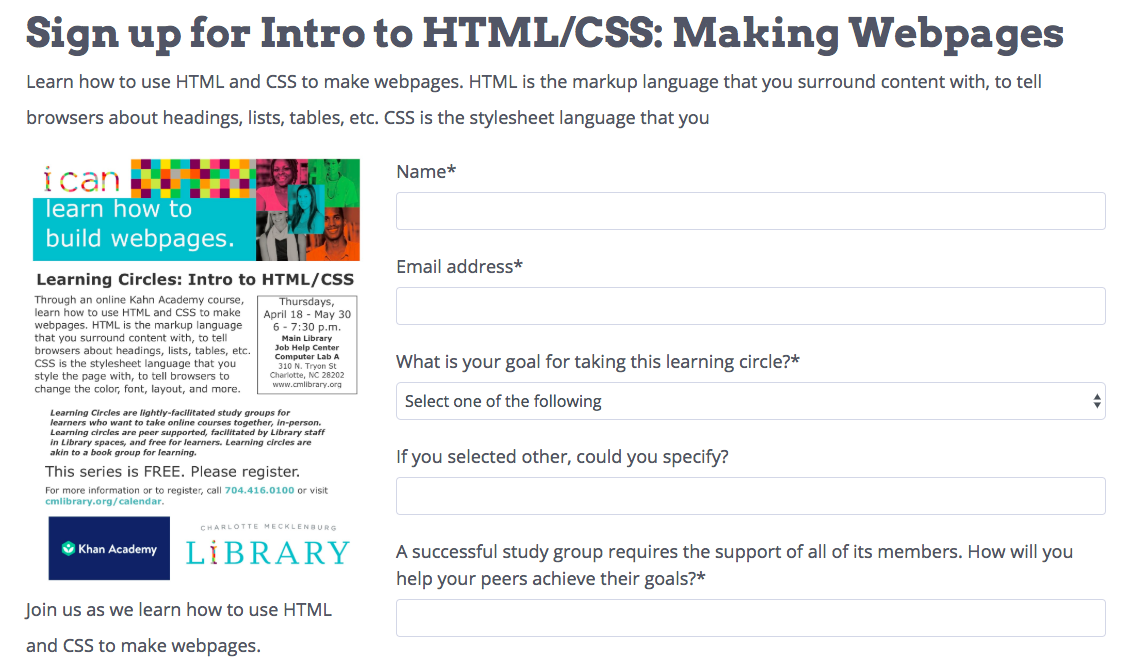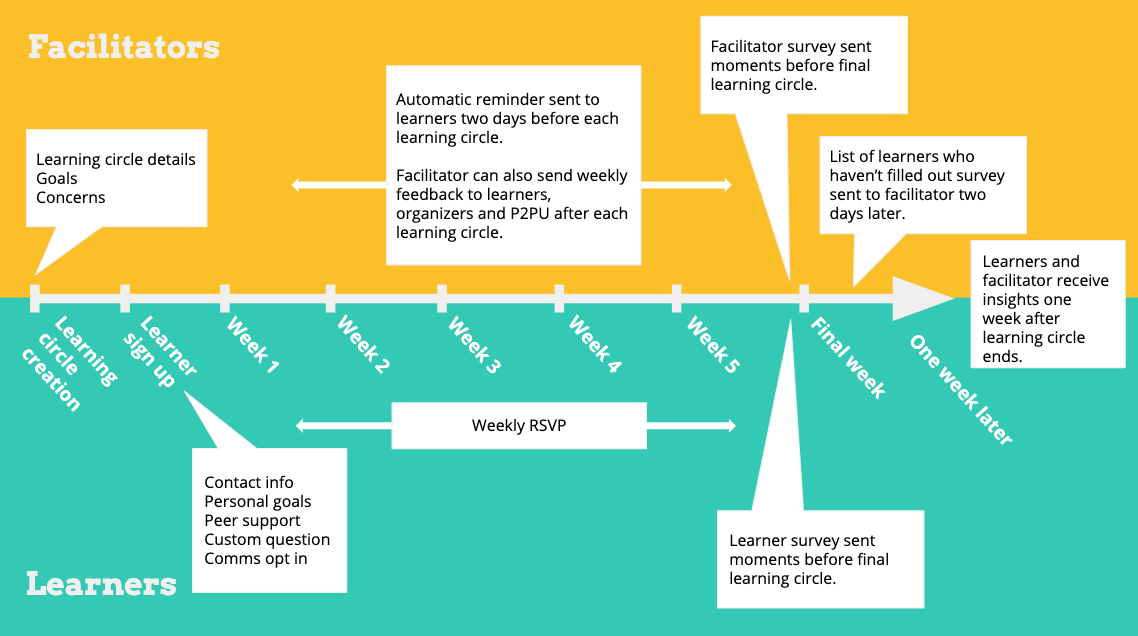Read & Watch
Suggested timing: 35 minutes
Preparing for a learning circle
Facilitating a learning circle requires about three hours/week on the part of the facilitator, most of which is spent in the actual learning circle. In addition to that, you’ll need to spend some time setting-up and cleaning-up each week, communicating with learners between each meeting, and familiarizing yourself with the upcoming week of course materials.
We recommend that you schedule your first learning circle for at least six weeks in the future. This will provide you ample time to promote your learning circle and address any outstanding questions with the P2PU team and community. As you think about planning for your first learning circle, here’s our recommended course of action:
6 weeks prior
- Discuss plans with any affiliated organizations
- Choose a course
- Find a space
- Choose date and time
- Confirm supplies will be available (laptops, headphones, pens, nametags, snacks, etc.)
4 weeks prior
- Establish additional web presence
- Customize a flyer
- Connect with local communities
- Publicize online and offline
2 weeks prior
- Confirm with all registered learners
- Confirm with venue
- Gather supplies
You can also download this list as a PDF checklist and check out the “Promotion and Outreach” section of the knowledge base, which features a number of flyer templates, messaging ideas, and logos that you can use for marketing your learning circle!
Gathering input from your community
Before you start running learning circles, you may want to run a small outreach project in your community to both get the word out and better understand the needs of potential learning circle participants. Below, we outline a few ways that the P2PU community has developed or used to integrate community opinions into learning circle program planning!
The Q method
The Q Method is a participatory public bulletin used to solicit feedback about course topics that people are interested in. It’s named after our friend Qumisha (a.k.a. Q) from Detroit Public Library, who came up with the idea as a way to promote learning circles at her library branch.
As you can see in the example above, the most popular course with 20 votes was Marketing in a Digital World. There was a tie for second place – Introduction to Public Speaking and Social Entrepreneurship 101 both received 16 votes. Based on the results, the Q offered both the marketing and public speaking courses as learning circles.
What’s great about the Q Method is that it both invites community contribution for deciding topics, and serves to promote the program. This concept has been re-used by learning circle facilitators around the world, and can also have applications for other community feedback issues, such as strategic planning, programming decision-making, and understanding community satisfaction and engagement. You can download a template to create your own Q method and see how others have implemented it around the world.
Focus groups
If you want more feedback on program design, you may wish to bring a small group of people together and ask them questions about what they are looking for in learning circles. This is a great way to not only generate data and insight, but also to get to know people and build relationships. In Kenya, libraries run focus groups as part of their learning circle training; we’ve adapted their focus group questions for you on the forum.
Community partnerships
Watch this video clip of Athanasia Fitos, a librarian from Miami, discussing the role of community partnerships in building a successful learning circle community. As you watch, think about (or discuss) your responses to these questions:
- How do you currently understand and document the needs, interests, and experiences of the various communities you serve?
- Which communities does your organization not serve who you might want to reach?
- What audiences or communities do you aim to serve through learning circles, and what might benefit or interest them most?
Here are some final thoughts from the P2PU community on how to best promote learning circles.
🛠️ How to create a learning circle on the P2PU website
Once you have selected your course and confirmed where and when you’re going to meet, it’s time to create your learning circle on the P2PU website!
The creation flow is a 5-step process; you can click through it all without needing to log in to the P2PU site. The only thing worth calling out here in more detail is “Step 5: Finalize”. Here, you have the option of answering two questions that will be shared with P2PU and a group of volunteer facilitators who we call the Welcome Committee.
- What do you hope to achieve by facilitating this learning circle?
- Is there anything that we can help you with as you get started?
Once you create a learning circle, we’ll automatically spin up a website for you to promote your learning circle. That will look something like this:

You’ll then receive a confirmation email which includes the link to your sign up page and a number of other resources. If you answered the questions in Step 5, the P2PU Welcome Committee will be copied on this email and someone will reach out to ensure that your concerns are addressed before the learning circle begins.
You can manage your learning circle at any time through your facilitator dashboard. From there, you’ll be able to:
- Edit the learning circle description
- Toggle sign up on and off
- Edit the date and time of individual meetings
- View details of learners who have signed up
- Send emails or SMS messages to individual learners or the entire group
- Share weekly feedback with learners, your colleagues, and P2PU
🛠️ Communication and feedback
Feedback is an important part of peer learning, and P2PU’s tools help gather and share information between learners, facilitators, and the P2PU team across the learning circle. P2PU holds user privacy to the utmost importance and we are compliant with the European Union General Data Protection Regulation (GDPR). Here is the type of communication that you can expect during a learning circle:

At sign up
When creating a learning circle, facilitators are prompted to state their goals for leading a learning circle and ask any questions or concerns they might have. Their responses are shared with a group of people that can assist a facilitator. Similarly, when learners sign up, they are asked what their goals are for joining a learning circle. They are then introduced to their facilitator in an email containing their answers to the signup questions.
During the learning circle
Each week, a reminder message is automatically sent to learners two days beforehand via email or SMS. Before the reminder is sent, you have the opportunity to log into their dashboard and customize the message. After each weekly meeting, you can record a weekly reflection on their dashboard and send it to your learners and/or P2PU.
Upon completion
At the end of a learning circle, learners and facilitators receive an email with a link to a survey that asks everyone to reflect upon the goal they first set, what worked well, what could be improved, and what their next steps will be.
In the final week of the learning circle, you may wish to give certificates to learners. You can read more about that process, and download a certificate template, from our knowledge base.
Additional readings & resources
You are, of course, encouraged to utilize whatever existing methodologies you use to identify learner needs and do community outreach, whether that be informal 1-1 discussion at a circulation desk or facilitated workshops. There are a number of resources out there that can help you discover new ways of conducting community outreach. In particular, we recommend:
- Design thinking for libraries (from IDEO, Chicago Public Library, and Dokk1), which adapts IDEO’s human-centered design methodology for use in library programs.
- Team Playbook (from Atlassian, the creators of Trello and Jira), which includes here is a framework for empathy mapping, which can help you both empathize with and derive insights from possible learning circle participants.
- ToolboxToolbox, which is a curation of business, design, and organizational change toolboxes from various companies and institutions, many of which touch on community outreach and user testing.